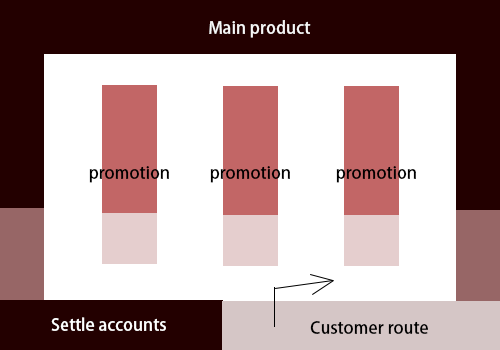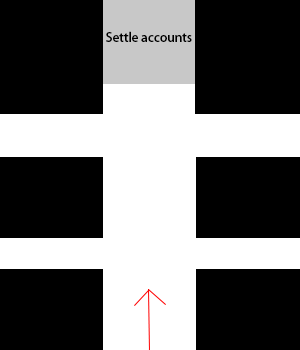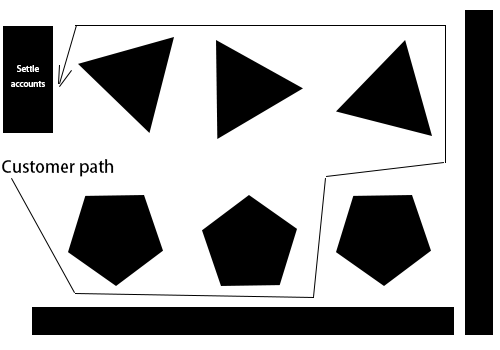The layout of a retail store refers to the in-store fixtures, the way products are displayed, the way goods are displayed, Different layout of retail stores will affect many, among which the most important is the shopping experience of customers. Proper layout of retail stores can not only help you highlight the first products sold in the store, but also increase the shopping time of customers and improve their shopping experience. Customers must prefer a well-organized store. So how do you choose the right store layout for you?
I believe you will have your answer after reading this blog!
What is store layout?
Before choosing the layout of retail stores, we should first make clear what are the determinants of store layout. Through research, it is not difficult to find that most people will first look to the left and then to the right when entering a retail store, and the movement path in the store also prefer to move from right to left counterclockwise. Therefore, we should combine the principles of aesthetics and psychology. Improve the customer experience in the store and lead them to the products we most want customers to buy.
The following will introduce five commonly used store layouts. I hope you can choose the most appropriate store layout according to the size, product, style, etc.
1. Free flow layout
Free flow layout is a bold attempt to break the conventional layout. There is no deliberate rule in this layout, and customers can freely choose their own moving path. Of course, the advantage of this way is that customers will certainly wander in front of the goods they are most interested in.
Advantages:
1. Suitable for small space
2. Is it easier to find out what products customers like
3. Suitable for retail stores with few products
Disadvantages:
1. Unable to guide customers directively
2. More products will clutter the store
2. Grid store layout
Grid layout is one of the most regular layouts in retail store layout, and it allows you to maximize the space of the store. Supermarkets, drugstores, grocery stores, etc., all seem to use this layout.
The feature of grid layout is that the display shelves are usually connected to one another. The main products of the store are at the front of the aisle, so the end of the aisle is the most important place of the store. Many stores use different display shelves here to further highlight the main products of the store.
There are studies, of course, that suggest that four-foot aisles are better at keeping people out of each other’s way, which improves the shopping experience!
Advantages:
1 .Customers can increase their browsing time in the store
2. You can selectively place promotional products where customers can see them
3. This layout has been fully practiced in practice
4. Suitable for a wide variety of goods, a large number of stores
Disadvantages:
Customers may not be able to find the products they need directly
Customers may not like your store’s product assortment
The shopping experience is low
The use of grid layout, you will need to store products regular, and interrelated, Wal-Mart is a good example, of course, how to improve the customer buying experience is also a very key point, can recommend the use of supermarket rack with labels. Simple standard display rack can also quickly help customers find the products they want, and can help you better group!
3. Herringbone store layout
Herringbone store layout is another regular layout updated on the basis of grid stores. It is more suitable for retail stores with a large number of products, rich types and long and narrow retail space.
Herringbone store layout has many of the same advantages and disadvantages as grid store layout.
Advantages:
1. Suitable for slender retail stores
Shortcomings:
1. Store layout is more compact, customer shopping experience decreased
It is not difficult to find that small hardware stores, convenience stores, and so on all use herringbones retail layout. In order to improve customers’ shopping experience, they usually set up promotional areas, and the stores have some welcome words.
4. Shop-In-Shops layout
The store-in-store retail layout, also known as the boutique store layout, is a kind of free flow layout, which greatly improves the user’s freedom, they can buy complementary products in different brand areas, we can use fixtures, walls, aisles, and so on to create a sense of a small shop inside the store.
Advantages:
1. Greatly increased the cross-selling probability
2. Can highlight the style of different brands
Disadvantages:
3. Customers may not walk through the entire store
4. It is difficult for stores to have a clear order for product classification
If you have to have more than one brand management, then I recommend you use this layout, you can let each brand tell their story in a store, of course, this needs to cooperate with the store in the store special display device, using the way of telling stories to let customers patiently explore your entire store, of course,We also have many Shop-In-Shop cases on our website, you can go to check!
5. Geometric retail store layout
This is the most creative layout of retail stores at present. Its main sales target is to target the new generation of young people. This layout of retail stores should not only make efforts in the layout, but also add more uniqueness in the display device and decoration style of the store.
Advantages:
1. It can attract more young people to shop
2. Help to create a personalized brand
Disadvantages:
1. Not very suitable (for unfashionable customers), for whom this kind of shop may be too strange
2. Waste of space, low utilization of space
If you want to create a personalized brand, then I highly recommend you to use this store layout, because it is really suitable for today’s young people. It’s also a great place for a brand to tell its story, and of course you might have to work a little bit on the fixtures of the store, and the usual fixtures don’t work for this kind of store.
There are many different layouts of retail stores. Here I introduce the five most commonly used layouts. Before deciding on the layout of retail stores, you need to consider customer, product, brand and other factors
Who are your clients, what are they like,
Whether your store has a wide variety of products,
Are you going to be a boutique,
These are to be considered, and the retailer’s display device, is also a very important factor in a store, it can directly draw out a store positioning, if you need to customize display props, we will or you a good choice!
Post time: Jan-11-2023






